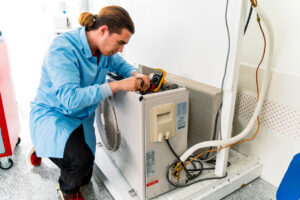Is your home safe for pets? In many homes across the country, pets are considered to be members of the family.
They are cared for almost as children are cared for in the home, and their loss may be mourned significantly by the family members. Just as people can become injured or worse when unsafe conditions are present in the home, the same holds true for furry family members. Learn how to:
- Create a safe space for pets
- Identify unsafe factors
- Safe pet toys
- Safety for aging pets
Many animals are naturally curious or may easily get into mischief when left alone for a long period of time. Pet accidents can happen at any time, but pets may be more likely to chew or eat things that they are not supposed to when you are not around. They may also run around and become entangled or even choked by loose cords and other items.
Creating a Safe Space in Your Home for Pets
Whether you are at home with your pet or away from the house, pets can easily get into trouble when they are not monitored. Because it may be impossible to monitor a pet at all hours of the day, creating a safe space for your pet to stay when you are not at home, while you are sleeping or when you are otherwise inattentive to your pet is important.
Identifying how much space your pet may need to be comfortable while you are gone is important. Some pet owners will crate train their pets, and others may place them in a safe room in the home, such as in a laundry room, while they are away.
When selecting an area of the home to turn into a safe for pets sanctuary, the temperature of the space should be considered. Ideally, climate controlled areas are preferred. Even garages and other non-climate controlled areas can become too hot or too cold for a pet in extreme weather conditions, so these spaces may not be ideal in many climates.

Identifying Unsafe Environmental Factors
Even when you are at home, your pet can still get into trouble. For example, pets may love to chew on kids’ toys, run into loose cords that can entrap them or chew electrical wires. Taking time today to walk through your home and to identify safety concerns is important.
Walk from each room in the home to inspect it from a pet’s eye view. Look for curtain cords or other cords that may be at a pet’s level. Move wiring for the TV, lamps and other items so that they are out of reach of pets. Place toys, shoes and other items behind a closed closet door. Ensure that food is not lying on a tabletop or in another area where your pets can reach it if they climb or jump up.
Because pets often spend time alone outdoors in a yard, it is important to inspect the yard as well. Electrical cords should be secured, and bodies of water, such as a pool or pond, should be enclosed. Children’s toys should be removed from the yard when they are not in use.
Windows should be kept closed, and this is especially true for homes with multiple stories. Pets have pushed through window screens and fallen to the ground below many times, so pet owners should not feel confident that a screen alone will keep a pet safe.
Safe Pet Toys to Keep in the Home
Many pet owners love to buy their pets toys. Toys can help to keep pets engaged and out of trouble that they may otherwise get into when left to their own devices. However, it should be noted that not all pet toys are safe for all pets.
For example, some chew toys that are suitable for smaller dogs may easily be shredded into small and unsafe bits of plastic by larger dogs, and these pieces of plastic can easily become choking hazards.
When you buy pet toys, take note of their durability and construction, and consider the size or type of pet that they were designed for. In addition, consider your own pet’s behaviors and mannerisms to determine if a specific toy is a safe option. When you do bring a new toy into the home, monitor your pet for a period of time to verify that the toy is being used in a safe way.
As Your Pet Ages Keep your Home Safe
Taking these steps today can help to keep a pet safe on a daily basis. However, it is important to note that pets age at a significantly more rapid pace than humans do. Because of this, their needs, behaviors and mannerisms may change considerably over a relatively short period of time.
Diligent pet owners should actively monitor their pet’s changing habits, behaviors and abilities, and they should make changes to the home environment as necessary to accommodate the needs of their pet. For example, an elderly pet may have trouble walking down steps leading into the backyard, so a special ramp may need to be constructed to assist the pet with safe mobility in their later years.
Many pet accidents can fortunately be prevented. By following a few key safety tips in the home and making several changes as needed, you may be able to promote the safety and health of your pet and minimize the risk of injury. Visit here Nice Heating and Air for the best HVAC services.

 SEE OUR SPECIALS
SEE OUR SPECIALS SCHEDULE SERVICE
SCHEDULE SERVICE





 Call 703-884-2376
Call 703-884-2376


